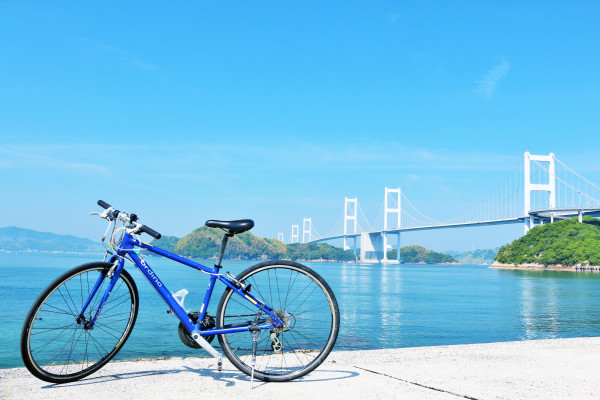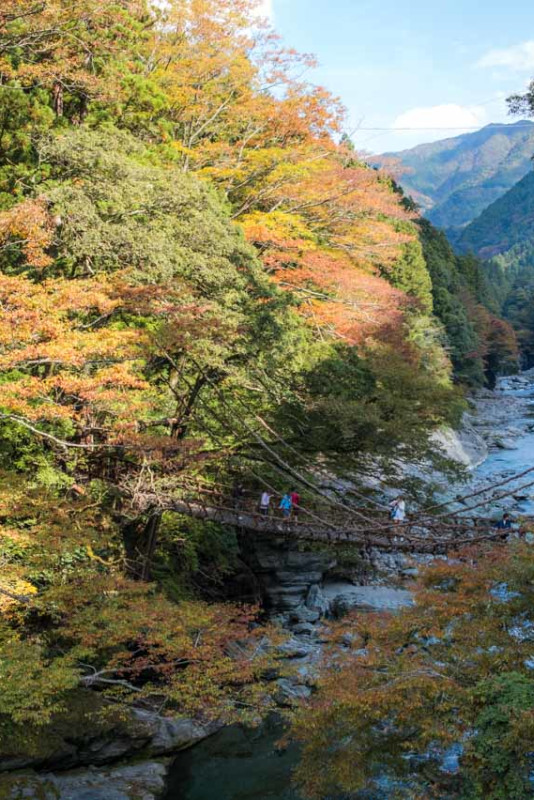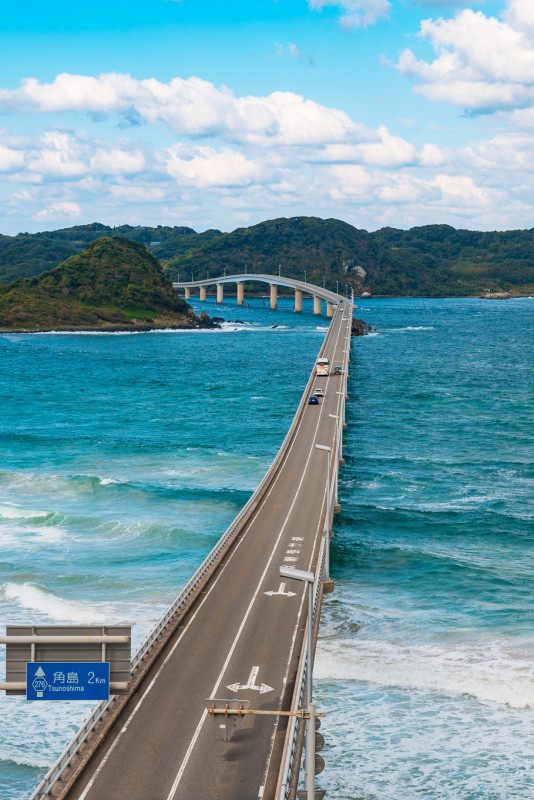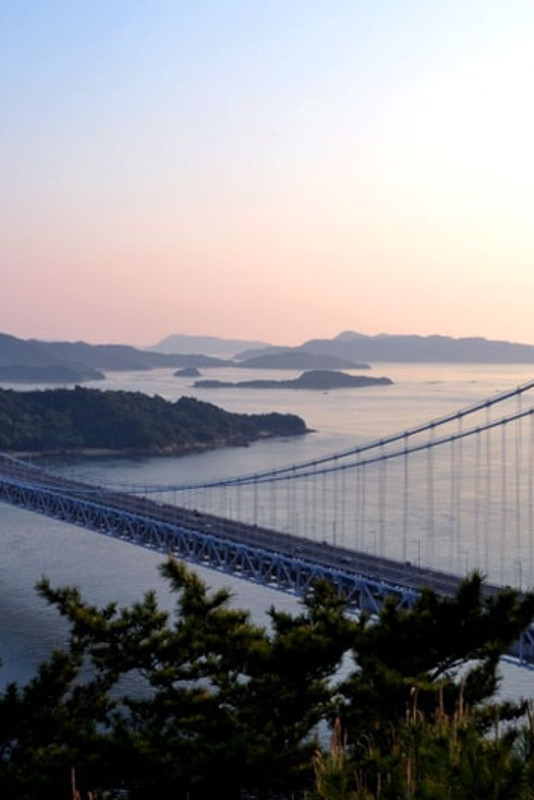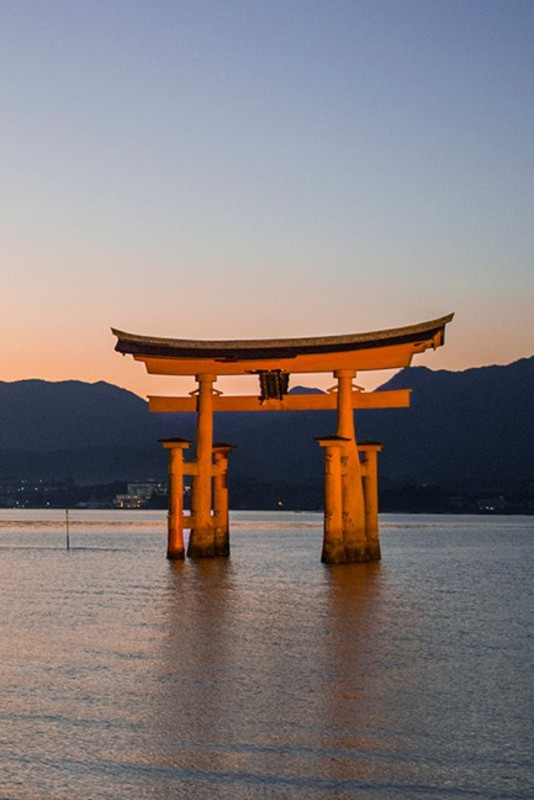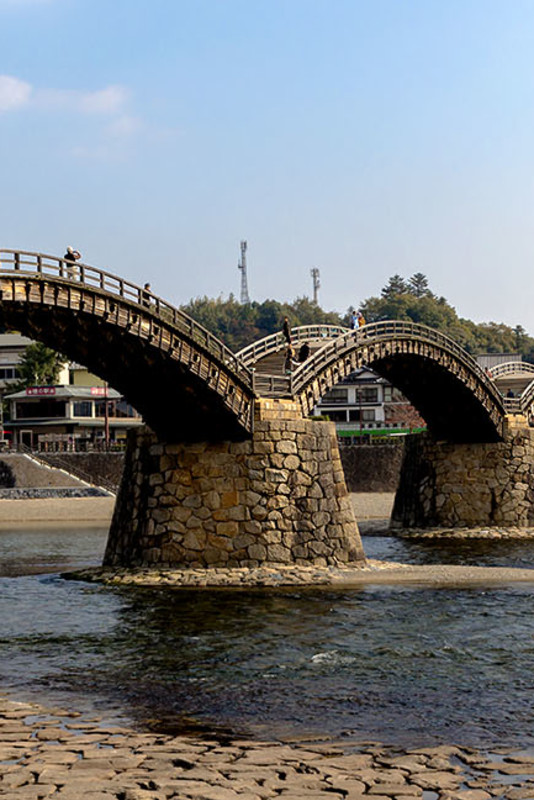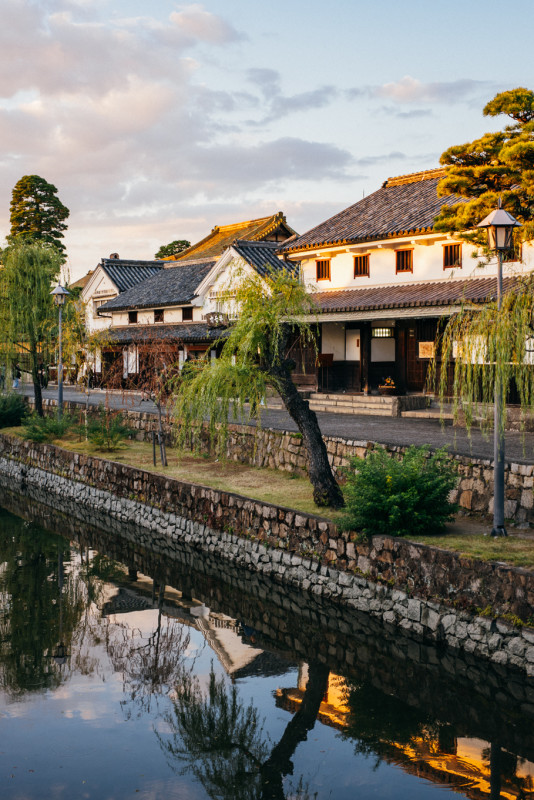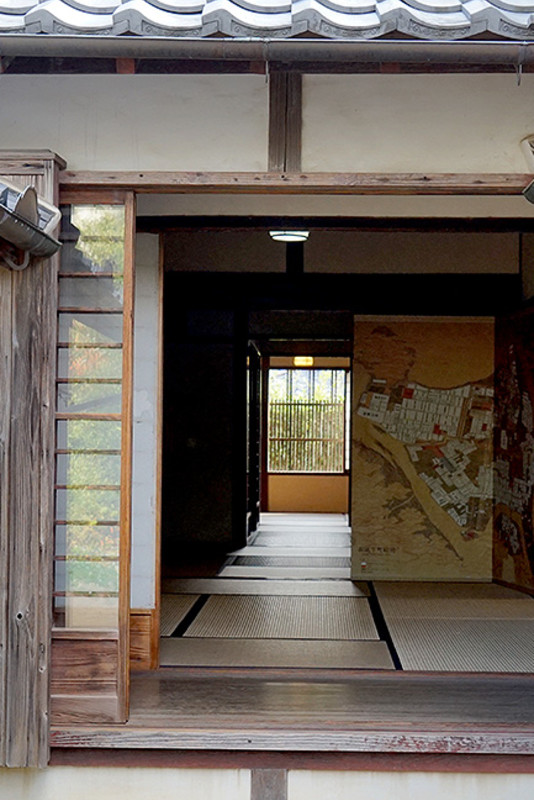Itineraries
An Active Trip through Hiroshima and Yamaguchi to Refresh both Body and Spirit

Pedal along the one of world’s most impressive cycling routes Shimanami Kaido, salute sun as it rises above the retro port town of Onomichi, gain unique perspectives of Hiroshima from its rivers and mountains, pamper yourself at a stylish onsen inn after visiting one of Japan’s most beautiful bridges and exploring the dramatic karst plateau of Akiyoshidai on this 4-day itinerary for the active traveler.
- Day 1
- Setoda, Shimanami Kaido and Onomichi
Travel: Osaka to Setoda
・Take the Shinkansen bullet train and local train from Shin-Osaka Station to Fukuyama Station (Approx 1 hour 10 min)
・Take a local train from Fukuyama Station to Onomichi Station (Approx 20 minutes)
・Take a ferry from Onomichi Port to Setoda Port (Approx 40 minutes)
The best of the Shimanami Kaido in Setoda
The Shimanami Kaido is Japan’s premier cycling destination, a stunning 70 km island-hopping route that connects Onomichi in Honshu with Imabari on Shikoku via a series of impressive bridges. Setoda on Ikuchijima Island, about halfway along the route, is one of the most picturesque sections. The quiet port town offers lovely seaside cycling and walking paths, some impressive visitor attractions and a variety of places to grab a drink or bite to eat.
Ferries make the journey between Onomichi and Setoda throughout the day and rental bikes can be transported on the ferry at no extra charge. Bikes can also be rented in Setoda on arrival. An 8km ride takes you along the beautiful coastline to “Lemon Valley” where many of the lemons that Setoda is known for are grown and the Tatara Bridge, one of the Shimanami Kaido’s most impressive bridges. Across the bridge, is the island of Omishima where Oyamazumi Shrine with its 3000-year-old trees and incredible collection of samurai treasures is located.
Back in Setoda, explore the opulence of Kosanji Temple and the Hill of Hope edifice wrought from imported Carrera marble, hang out in cafes around the port or along the old high street or a soak at Yubune in one of the region’s coolest public bathhouses. To go a little deeper, contact SOIL Setoda for details about tours of organic lemon orchards and trying Zen meditation at Kojoji Temple which overlooks the port.
After arriving back at Onomichi Port, why not enjoy an early evening cocktail at the Onomichi U2 waterfront complex or a craft beer at
Onomichi Brewery?
Accommodation: LOG
This boutique hotel, designed by renowned architect Bijoy Jain, is a one-of-a-kind resting place where you can fully recuperate and refresh after an active day on the Shimanami Kaido. Bijoy Jain has achieved something quite remarkable with his refurbishment of a 1960 apartment building, testament to Onomichi’s commitment to reimagining the future of the town while respecting its past. The rooms are simply beautiful, with every detail carefully designed and crafted to enhance the hotel’s calm atmosphere. Meals, based on the freshest of locally sourced ingredients, change with the seasons and LOG is an excellent option for vegan travelers.
URL: https://l-og.jp/en
- Day 2
- Onomichi and Hiroshima
Greet the day from Mt Senkoji
Get an early start and head to the top of Mt Senkoji along narrow alleyways lined with tumbledown houses, saying good morning to the cats you will no doubt come across on your way. Take in the panoramic view of Onomichi and perhaps find a secluded spot for a little yoga or quiet meditation before heading back down via Senkoji Temple, Cat Alley and Ushitora Shrine.
Locally-grown organic tea
Before getting on the train to Hiroshima, take on the challenge of finding Tea Stand Gen, which serves locally-grown organic tea (selected as the tea of choice for world leaders at the 2023 Hiroshima G7 Summit) in a delightfully worn converted house down an almost unfeasibly narrow alleyway.
Travel: Onomichi to Hiroshima
・ Take a local train from Onomichi Station to Mihara or Fukuyama (Approx 15-20 minutes)
・ Take the Shinkansen from Mihara Station or Fukuyama Station to Hiroshima Station (Approx 20-30 minutes)
・ Alternatively, take a taxi to Shin-Onomichi Station (Approx 10 minutes) and take the Shinkansen from Shin-Onomichi Station to Hiroshima Station (Approx 40 minutes)
Learn about the Hiroshima A-bombing and the city’s recovery
Today, Hiroshima, the site of the world’s first atomic bombing, is a vibrant city which looks to the future while remembering the terrible cost of war. Spend some time among the people of Hiroshima and one cannot help but marvel at the city’s resilience and remarkable recovery.
Visiting Hiroshima’s Peace Memorial Park, Peace Memorial Museum, and the World Heritage Site of the Atomic Bomb Dome memorial is the primary motivation for most who visit Hiroshima. It is a sobering and often emotional experience. If time allows, seek out a quiet spot among the trees to reflect on the experience before returning to the hustle and bustle of the city.
Get a different perspective on Hiroshima
Two active tour options offer the opportunity to learn more about Hiroshima’s past, present and future from local guides.
Sokoiko! Peace Cycle Tour
Starting from Peace Memorial Park, friendly local guides lead you around central Hiroshima, stopping at significant sites related to the A-bombing. Focusing on the city’s recovery as well as on the tragedy of the bombing, the Sokoiko! Peace Cycle Tour is a moving experience that is highly rated by visitors from around the world.
URL: https://www.sokoiko-mint.com/
Magic Island SUP Tour
With six rivers that flow through its center, Hiroshima deserves its nickname the “City of Water” as much as that of the “City of Peace”. Stone steps down to water make (SUP) stand up paddle boarding an excellent alternative way to explore the city. Magic Island, a short walk from the guides people of all abilities on a 2-3 hour tour which includes views of the iconic A-bomb Dome from the water below.
URL: https://mail93309.wixsite.com/magicisland-sup/
Hiroshima Okonomiyaki
There is no better place to experience how welcoming the people of Hiroshima are, than at the grill in a local okonomiyaki shop. It is no exaggeration that most of Hiroshima’s population was raised on this hearty layered pancake and watching it being prepared by a veteran chef is as entertaining as the finished dish is delicious. Vegan diners can also enjoy the full okonomiyaki experience at Nagataya and Jirokichi.
Bar hopping in Eki Nishi
To raise a glass with the locals after dark, head to Eki Nishi, a small area crammed with bars and eateries next to Hiroshima Station.
Accommodation: Hilton Hiroshima
A short taxi ride from Hiroshima Station and within walking distance of Hiroshima Peace Memorial Park, the Hilton Hiroshima is the perfect place to base yourself during a visit to Hiroshima. With well-appointed, modern rooms, and excellent guest facilities, the Hilton Hiroshima is a luxurious refuge in which to relax, recharge and ready yourself to explore the city or head to your next destination.
Four restaurants serve Japanese and international cuisine using locally sourced ingredients. In the Executive Lounge on the 22nd floor, guests can enjoy evening cocktails and light snacks, as well as a variety of beverages, while taking in the views over islands of the Seto Inland Sea and surrounding mountains.
A guest relations officer is also on hand to provide assistance with sightseeing and restaurant reservations. Take the relaxation up another level with a visit to the luxurious Spa by L’OCCITANE.
URL: Hilton Hiroshima
- Day 3
- Hiroshima, Iwakuni and Yuda Onsen
Hiroshima Morning Forest Trek
Join an early morning trek up Mt Futaba which overlooks the city of Hiroshima. After visiting historic Toshogu Shrine, your guide will lead you along a hidden forest trail that passes under 100 red shrine gates to a quiet lookout point watched over by fox statuettes. Here enjoy a specially prepared bento breakfast (vegan option available with advance reservation) and make your own matcha green tea while taking in the view over the city and out to the islands in Hiroshima Bay.
URL: https://en.asageshiki.com
Travel: Hiroshima to Iwakuni and Kintaikyo Bridge
・Direct buses to Kintaikyo Bridge, Iwakuni leave from Hiroshima Bus Center (Approx 55 minutes)
・Alternatively take a local train from Hiroshima to Iwakuni (Approx 50 minutes) and travel to Kintaikyo Bridge by taxi (Approx 12 minutes) or local bus (Approx 30 minutes)
Kintaikyo, one of the most beautiful bridges in Japan
The Kintaikyo Bridge in Iwakuni with its five elegant wooden arches that span the 200m-wide Nishiki River is an incredible example of traditional Japanese architecture and engineering.
Originally built in 1673, the bridge has suffered flood damage on several occasions. However, thanks to continual maintenance and reconstruction we can still enjoy this extraordinary bridge today. As well as walking across the bridge, be sure to appreciate the intricate, and beautiful, woodwork from beneath too. The riverside here is particularly pretty during cherry blossom season, and, if your schedule allows you to linger until dusk, the bridge is illuminated most evenings of the year and displays of traditional cormorant fishing are conducted on summer evenings.
Kikko Park & Iwakuni Castle
Kintaikyo Bridge takes you into Kikko Park, which now occupies that area where the feudal lords of Iwakuni used to live. It is a lovely area to walk around, enjoying the preserved historical buildings and seasonal flowers which add color throughout the year. Tea ceremonies open to the public are held many Sundays of the year at Kikko Tea House and one of Iwakuni’s more unusual attractions are its white snakes which are venerated as a guardian deity of households. Near the White Snake Museum, you can also see some of the cormorants used in traditional cormorant fishing displays.
On the mountain overlooking Kikko Park is Iwakuni Castle. The history of the original castle was short-lived, destroyed in 1615 by order of the Shogun only seven years after it was built. Although the current keep is a reconstruction that only dates from 1962, accessible by ropeway, the high vantage point offers a fantastic view of the Kintaikyo Bridge and the river below.
Iwakuni Sushi, Sake and Become a Samurai
Local culinary specialties include pressed Iwakuni Sushi and lotus root (renkon). Hirasei, which has a great view of Kintaikyo Bridge is known as the place for Iwakuni Sushi.
For something lighter, try a simple tasting menu which includes bite-sized samples of local delicacies, accompanied by locally brewed sake at Honke Matsugane visitor center housed in a restored 19th century merchant house which once sold hair oil to the samurai. By arrangement, you can also be dressed in faithful reproductions of samurai battle armor here for an enviable photo souvenir.
Murashige Sake Brewery
As our next stop is best accessed from Shin-Iwakuni Station (an 8-minute taxi ride from Kintaikyo Bridge), before you hop on your Shinkansen, visit
Murashige Sake Brewery (Japanese) to see the world’s largest sugi-dama (the cedar ball that hangs in front of breweries and sake shops) and try a selection of their sake. It is located right across from the Shinkansen Station.
Travel: Iwakuni to Yuda-Onsen
・Take a taxi from Kintaikyo Bridge to Shin-Iwakuni Station (Approx 8 minutes)
・Take a Shinkansen to Shin-Yamaguchi Station (Approx 30 minutes)
・Take a local train to Yuda Onsen Station (Approx 20 minutes)
Yuda Onsen
As you leave Yuda Onsen Station, you cannot fail to notice the tall white statue of a fox that greets arrivals. It is said that it was a wounded fox that first discovered the power of Yuda Onsen when it was instantly restored on contact with the healing waters. People have been coming here to reap the benefits for themselves for hundreds of years.
There are several public ashiyu, hot springs in which to warm and relax your feet, in the town. At the chic, modern Kitsune-no-ashiato (Foxes Footprints) Cafe and Information Center, you can enjoy ashiyu both inside and in the garden, as well as coffee, desserts and local sake tasting sets.
Accommodation: Matsudaya Hotel
A hotel that has been around for over 300 years, when you step into Matsudaya Hotel you will feel like you have stepped back in time. The main building was built in the Taisho period and guests who stay in this building are also able to see the garden from their room. Meals are served in the guest rooms, providing privacy as guests dine on exquisitely prepared dishes using seasonal and local ingredients. A stay at this historical property is a must when visiting Yamaguchi City and the Yuda Onsen area.
URL: https://www.matsudayahotel.co.jp
- Day 4
- Akiyoshidai
Travel: Yuda Onsen to Akiyoshidai
・Akiyoshidai is a 30-minute drive from Yuda Onsen. Traveling by rental car or chartered taxi is recommended.
Akiyoshidai Plateau and Akiyoshido Cave
Drive a mere 30 minutes drive from Yuda Onsen and Yamaguchi City and you will find yourself in what seems like another world entirely.
The views of closely cropped greenery pierced by white limestone outcrops across the 4,500 hectare Akiyoshidai Quasi National Park are something to behold. After exploring the massive Akiyoshido Cave it is most common to enjoy the karst plateau by car, but there is an excellent network of well-marked hiking trails and bicycles available for rent from the Akiyoshidai Visitor Center. With Segway tours also on offer (starting at Chojagamori Parking Area), there is more than enough to keep you active and busy in this surprising corner of the Setouchi countryside.
Sake made from “water of the gods”
Just under 10km from the visitor center is Beppu Benten Pond, a cobalt blue spring filled with water that filters through the karst. This spring water, along with locally grown rice, is used to make award-winning Ohmine sake.
An inspiring rural revitalization success story,
the brewery, which was originally established way back in 1822, but closed in 1955, has attracted attention for its minimal, sophisticated branding after being relaunched in 2010. Sake is available to try as well as buy, as well as other drinks and cool merchandising at the shop that is attached to the brewery.
































































